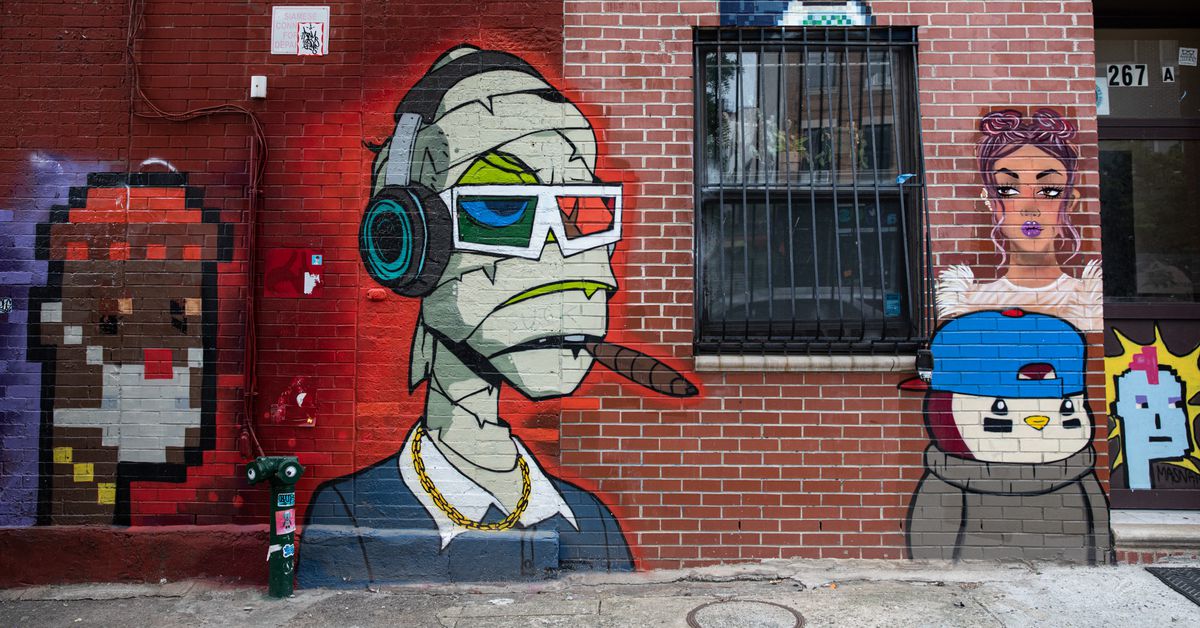We use cookies and other tracking technologies to improve your browsing experience on our site, show personalized content and targeted ads, analyze site traffic, and understand where our audiences come from. To learn more or opt-out, read our Cookie Policy. Please also read our Privacy Notice and Terms of Use, which became effective December 20, 2019.
By choosing I Accept, you consent to our use of cookies and other tracking technologies.
Filed under:
Another NFT on the wall
Last year, NFTs started to appear on a three-story brick apartment building in Williamsburg, Brooklyn. Located at the intersection of Grand Street and Roebling Street, the murals are the work of a graffiti artist called Masnah. Each one is a commission from the token-holder, faithfully reproduced. There are nearly 60 in total, with more still coming in, a kind of physical testament to the NFT boom.
Starting from the graffiti world, Masnah was surprised at how graffiti artists were selling NFT versions of their work — and how few were trying to take NFT imagery to the street. “All the big names in graffiti were just doing renders of their art as NFTs,” he remembers, “so I wanted to approach NFTs from the graffiti side.”
After talking the idea through in the CryptoPunks discord, he started taking commissions. “The power of graffiti is that you see it in every corner, right? It’s alive. It’s part of public space,” he says. “I thought that the physical space would be a good place to make these.”
Masnah’s first commission was blocks away, painting a cowboy CryptoPunk on North 14th Street between Nassau and Wythe avenues. The mural itself got some attention, but it really took off when the owner started sharing it online, with the kind of conspicuous consumption that was inescapable during the NFT boom.
“He flexed it,” Masnah remembers. “When he put that on Twitter, it kind of blew up because no one had done it before.”
That summer, NFT owners were flush with cash, and many were willing to pay to see their profile picture images in physical form. Soon, Masnah was getting dozens of commission requests, so many that he started putting them all in one place: the Roebling apartment building. The building owner was sympathetic to the project, even putting an anti-graffiti coating over the murals in case anyone tried to tag on top of them.
Meanwhile, the commissions kept rolling in. For NFT owners, getting a spot on the wall was part-flex and part-investment. “The owners of these assets saw the value of me painting it in the street,” Masnah says. “If I did the picture, it would get all the attention on Twitter that day.”
Eventually, Masnah put his commission system on the blockchain too. After getting stiffed a few times, he started his own NFT collection, dubbed “Another Flex on the Wall.” To commission a mural, token-holders buy one of Masnah’s tokenized bricks, priced at 1 ETH, 1.5 ETH, and 2.5 ETH depending on the mural’s size. The mural itself goes on the blockchain too, linked back to the original token.
“It’s the first collection of graffiti on-chain. Before NFTs, you couldn’t really own graffiti. You had these photographs from [famous graffiti photographers] Martha Cooper and Henry Chalfant, who documented the graffiti and took these famous pictures of the trains. Their photographs are worth a lot of money but the guy who painted the train, his work isn’t even really in the market. He’ll never get any credit for that. So now with this technology, as street artists we’re able to own that wall.”
While NFTs typically represent digital images, Masnah’s project fits into a more recent trend of tokens linked to physical objects. In most cases, the object itself is either kept in custody by the minter or bought and sold independently from the token. The system has been used to sell tungsten cubes, sell a physical painting by Damien Hirst, and manage a marketplace of collectible luxury items.
In the meantime, the mural-for-hire business is spreading. Masnah has heard about an artist called Manny Links doing a similar business in LA, although the rates are lower and he hasn’t found a single building — at least not yet.
Author
Administraroot


